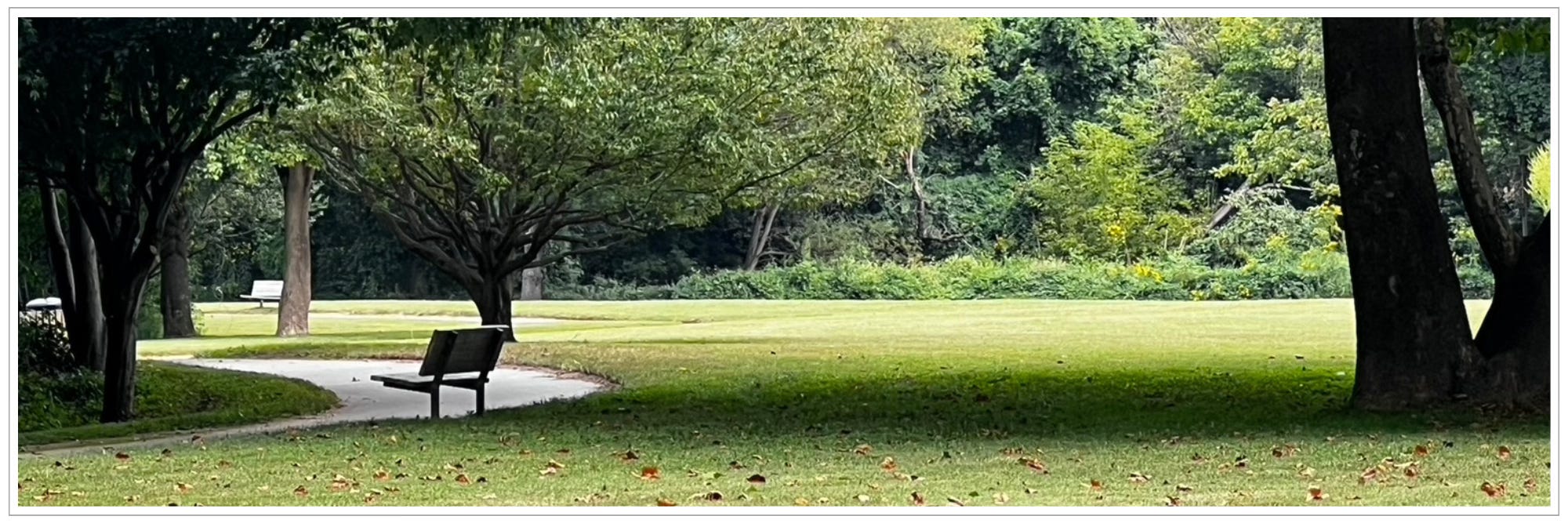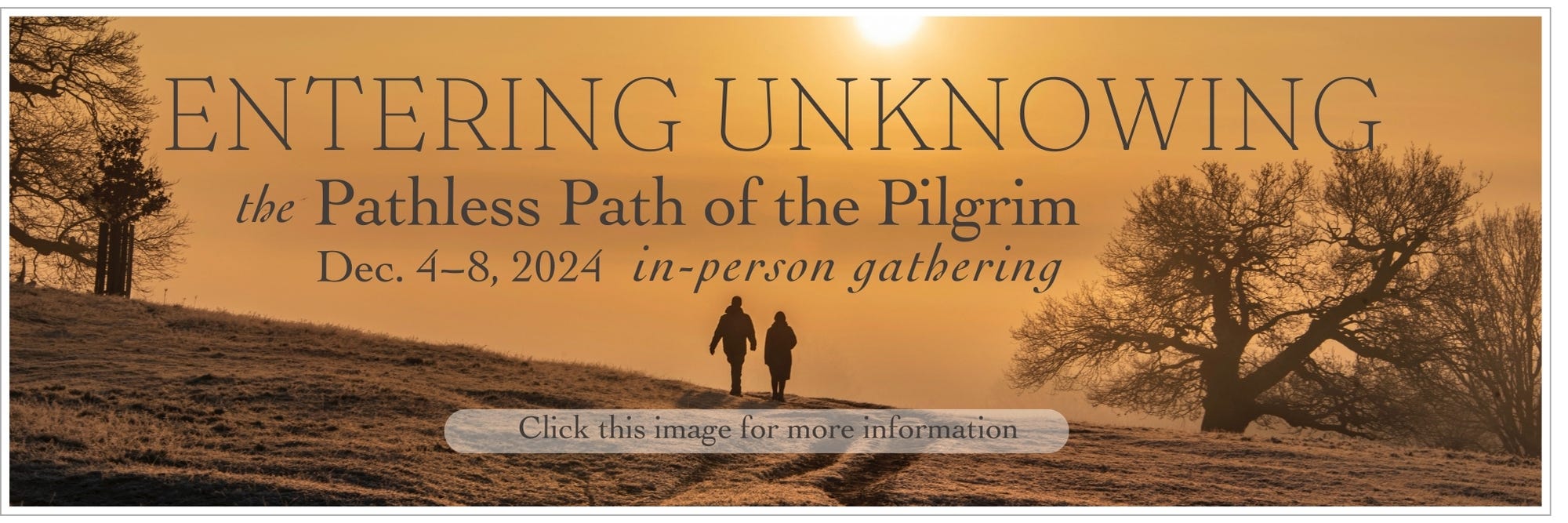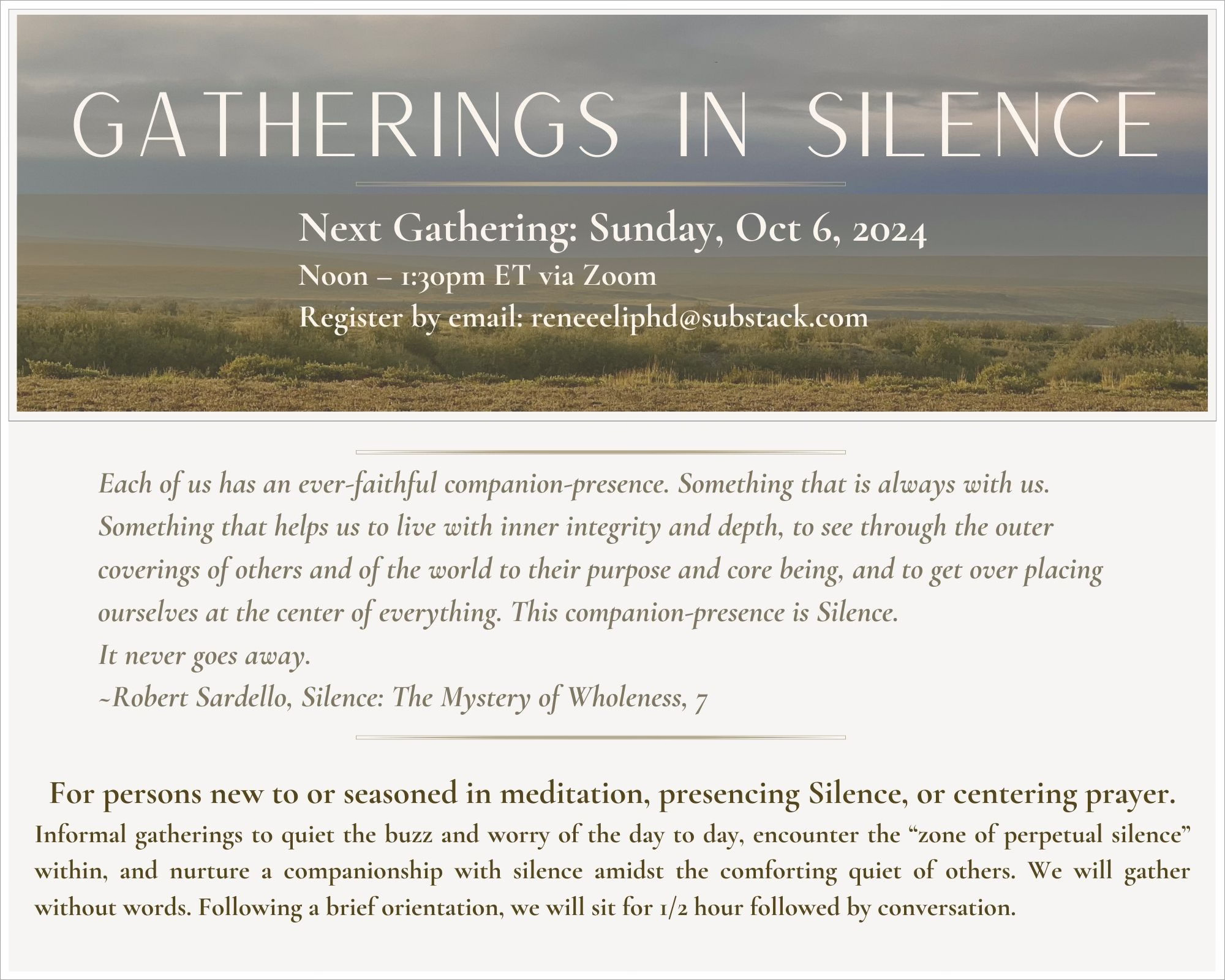Dear Friends and Family,
As I write, Francine’s inland sweep moves on, back toward the Atlantic, having given these mountains a sip of rain and the full flavor of early autumn. First leaves have begun to fall. I welcome the soon stillness of the shorter days in the northern hemisphere.
I am humbled by your response to last week’s “Pathless Path of Pilgrimage” letter announcing the December in-person gathering. Four spots remain. To you who registered, thank you. To you who are considering joining us for this ‘pilgrimage in place’, I hope you will.
Please email Doreen to register: tanenbaumd@gmail.com. You can also reply to this email or reach me: reneeeliphd@gmail.com
In more news, on Saturday, a small circle gathered on Zoom for a rich, in-depth conversation following the recent series on silence, solitude, and simplicity. I offer reflections from that conversation below.
These reflections are not fully formed. They’re notes really. But I hope you will get a sense of the richness of our conversation and an image of how sacred traditions have offered practices that reflect recognitions about how we perceive existence and so, open us to the way of the experience of the mystery of being.1
With love,
Renée
Stillness and Threefold Cord of Perception
Entering silence and inner solitude, and embracing a life of simplicity can be found across all sacred traditions. In the inner quietude of these practices, we soon discover we have entered a primordial stillness. In the depths of stillness, we touch the mystery of being.
Peter Kingsley writes this of stillness in the pre-Socratic Greek traditions:
The outer techniques the Pythagoreans practiced—the silence, the deliberate calm, physically not even moving—weren’t simply ends in themselves. They were means that were used for the sake of reaching something else. . . .
Their purpose was to free people’s attention from distractions, to turn it in another direction so their awareness could start operating in an entirely different way. The stillness had a point to it, and that was to create an opening into a world unlike anything we’re used to: a world that can only be entered ‘in deep meditation, ecstasies, and dreams’.2
He continues a few pages later about the purpose of stillness.
It was a method of coming as close as possible to the divine world.3
The physical body ends in stillness. Where the substance of the body ends is the inner within of where it begins. The inner within of where the body begins is where everything begins.
Everything begins in utter stillness.
Life is the expressive activity that bubbles up moment by moment out of the mysterious void that is the stillness we encounter when we get very quiet on the inside.
That inner quietude pulls a pin on the scaffold the ego erects to give us standing in the world.
We need a healthy ego structure to stand in this world. But in the inner quietude of stillness, the structure comes tumbling down. We see through to the tender innocence of our being as an expression of Being itself. Just then, we are humbled, and true.
The emptiness we may perceive in stillness is not a void that would seem to annihilate us but a sacred presence that is never not there.
We get a bit more esoteric now. See where the reflections that follow take you in your own. . . .
Threefold Cord of Perception
Mystic G. I. Gurdjieff4 said we are three-brained beings. He referred to the perceptual centers as:
vital feeling intellectual
Gurdjieff insisted that until we harmonize acting from these three centers as one integrated whole, we are not fully human.
One person in the group added that Rudolf Steiner made a similar observation, offering the threefold nature of the human.
. . .
Neuroevolutionary science maps chordate evolution across the unfolding of the nervous system. The nervous system has evolved as ‘layers’ one on top of the other like this:
brain stem (vital functions) midbrain/limbic system (feeling) neocortex (intellect, embodied cognition)
While this mapping is woefully oversimplified, we can see here the threeness.
These three are always functioning in tandem as one integrated whole. But by the fact of the primacy of the intellect in making meaning of our human existence, we tend not to recognize that we perceive the world through all three systems. By systems, we mean that these nervous centers are but nexuses of the functioning of these integrated perceptual systems across the whole body.
. . .
Philosopher Jean Gebser and others have said that the human has unfolded as three “structures of consciousness” across epochs:
Magical or animist (vital, aliveness in and of the world) Mythic (feeling, psyche/soul) Mental (intellect, rational thought + visual perspective)
One person in the group shared that in Judaism intuition is a fourth, higher mode of experiencing/perceiving. The Sufi imaginal realm would seem to correspond with this higher mode.5
What Might All This Say?
Well, first, we see tremendous correspondence between the mysticism of Gurdjieff (and others), the science of neuroevolutionary anatomy and physiology, and the philosophical underpinnings of consciousness studies. We cannot forget that the philosophical tradition of the West and so, the sciences, too, are birthed out of mysticism. Birthed in fact out of mystical stillness.6
But back to the cord: we can put a little more flesh on the bones without adding too much by saying:
Vital is the living body in metabolic and sense-making relation with the world.
(We can add that the gut is often referred to as the second brain but may in fact be the first.)Feeling is the heart in dynamic relation with self and other.
(the heart organ and limbic system are intimately intertwined, the heart organ itself being a powerful organ of perceptivity)Intellect is the faculties of thought that, purely on a perceptual level, make meaning of existence, experience, emotion, and relation.
Pairing the Practices with Modes of Being
Entering silence is a practice of open receptivity to the world.
We make each atom of our being an ear (Rumi). Whereas with seeing, we can direct the eye to what we wish to see in the world, with listening, we must receive the world. Entering silence is whole-bodied. When entering silence, we perceive from the stillness within to the stillness everywhere.7
Entering silence is open attunement of the body. Entering silence, we restore a more primordial way of being.
. . .
In solitude, we touch down into the heart of feeling. Solitude brings us to the inner quiet of our own innermost. We encounter self.
From inner recognition of self, we are open to feeling with and of an other.
Entering solitude is open receptivity of the heart.
. . .
Embracing simplicity is a practice of quieting the mind’s inclinations to seek comfort and security, and control.
When the mind is not pulled by anxieties, ambitions, and activities to control what’s next, the cognitive faculties of thought have the ‘space’ for making meaning of the direct experience of being, opening through us moment by moment.
We come to the plenitude of potentia awaiting our presence to it.
Embracing simplicity is surrendering security and control and letting life come.8
We circled many threads in this conversation, including grief, transformation, and these unique times. And I would say we came to the summative question:
In the depths of stillness, might it be that we become a perceptual wholeness experiencing and unfolding as the mystery of being?
This is a paraphrase of Valentin Tomberg who writes that esotericism is the “way of the experience of the reality of the spirit,” in Meditations on the Tarot: A Journey into Christian Hermeticism, trans. Robert Powell (New York: Jeremy P. Tarcher, 1985), p. 7.
Peter Kingsley, In the Dark Places of Wisdom (Point Reyes, CA: Golden Sufi Center, 1999), p. 181.
Ibid., p. 186.
P. D. Ouspensky’s In Search of the Miraculous is a good starting point for acquainting with the teachings of Gurdjieff.
In which case, the “line” between mode and realm gets very blurry. These may correspond also with what Jean Gebser refers to as perceptual verition in the Integral mode, which we do not explore here. See fn 7. Henri Bergson, Creative Evolution, does reflect philosophically on intuition but puts it between instinct (vital) and intellect.
See Peter Kingsley, In the Dark Places of Wisdom and Reality, for a groundbreaking hermeneutic of how sacred traditions gave birth to not only Western thought but Western civilization as a whole.
Jean Gebser, Ever-Present Origin, articulates organs of perceptivity for each structure of consciousness. For the Magical (animist), he points to the gut and ear. For the Mythical, he points to the heart. For the Mental, he points to the eye and neocortex. For the Integral, he does not articulate an organ of perceptivity but describes “verition” as the perceptual activity.
Further reflections on the pairing of this practice with the intellectual mode suggest a movement toward gnosis in the poverty of intellectual grasping.









Renée, sorry to have missed that meeting, from what you share here is sounds so velvety and rich. Funny that the stigma of stillness is often thought of being abandoned in a void. And yet isn't that the threshold that needs to be crossed. A complete emptiness, that is totally vacant. A clearing away of all the data, input, stress, expectations. The scrolling of the mind. The sacrifice needed to open to the expanse of being, of presence! LIFE itself. An exquisite sense of being both embraced and embracing.
"The emptiness we may perceivein stillness is not a void that would seem to annihilate us but a sacred presence that is never not there."
So well said, Renee! I may use this quote in my upcoming presentation at this year's Gebser Society conference.
In regards to the Threefold Cord of Perception, I find a very important correlation to also exist with the Daoist concept of the Three Treasures: Jing (vital) in the lower dantian; Qi (feeling) in the middle dantian; and Shen (intellectual) in the upper dantian.